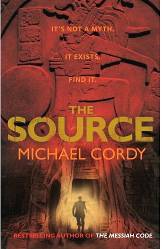Geraldine Brooks’ novel “The People of the Book” (2008) tells the story of a (fictional) Australian book conservator called Hanna Heath, and her encounters with a (real) codex called the Sarajevo Haggadah. In this sense, it is very much akin to the Voynich Manuscript novels I review here, which typically use the mystery of the VMs as a projective backdrop for their quasi-historical stories of life, death, passion and (occasionally) beauty, plucking the occasional codicological thread from our collective skein of Voynichological ignorance to frouf up into a faux Restoration wig.
One page in particular is returned to again and again: I wished this had been on the book cover so that I could see for myself what the fuss was about. Well, here it is, book fans (and there are plenty more on this Talmud site, and on this facsimile publishing site here):-

Sarajevo Haggadah – family seder illustration
Brooks has given her book a formal, almost musical structure: chapters set in Hanna’s present day ping-pong with chapters recounting enjoyable storylets of the Sarajevo Haggadah’s (imagined) past, each evoked by a single codicological detail – an insect’s wing (Parnassius mnemosyne leonhardiana, just so you know), a missing clasp, wine stains, saltwater, a single white hair. In each case, the life and atmosphere of a particular historical Jewish community is nicely evoked: and there are plenty of little structural surprises scattered throughout to keep a sense of movement in the narrative.

Sarajevo Haggadah marginalia from Venice, 1609
In one important sense, the point of the novel is that it tries to draw a parallel between (a) the process of trying to get to know the past of an object, and (b) the process of trying to get to know oneself: this is, after all, what history (as a tool) is for. Yet despite aiming her bow in such a noble direction, Brooks doesn’t quite hit the bullseye: though her protagonist finally uncovers the secret lives both of the haggadah (just as I’ve said with the VMs, incandescent lighting rocks) and of her family, she remains fundamentally the same shallow, dissatisfied shagette we met in the first chapter.
Yet in other ways, the real meat of the novel is in Brooks’ account of the codicology, based in part on observing real-life Austrian book restorer Andrea Pataki working with the actual Sarajevo Haggadah in December 2001. Brooks’ description of the texture and sheer tactility of an up-close (but slow-motion) encounter with a ancient manuscript is both detailed and (in my experience, at least) highly evocative of how this kind of thing actually does play out in reality. If you won’t ever get to touch a real-life manuscript yourself, maybe reading “The People of the Book” isn’t such a bad alternative. 🙂
Look, I enjoyed it and I hope it does well for Brooks: with “The Reader” doing so well at the cinema, I can quite imagine this being picked up (doubtless Kate Winslet could do a bonza Ozzie accent). Yet whereas The Reader was about hiding illiteracy, Brooks’ book is more about uncovering literacy, using codicology to imaginatively reconstruct the lives of the people behind this amazing book. As such, I can only applaud.
